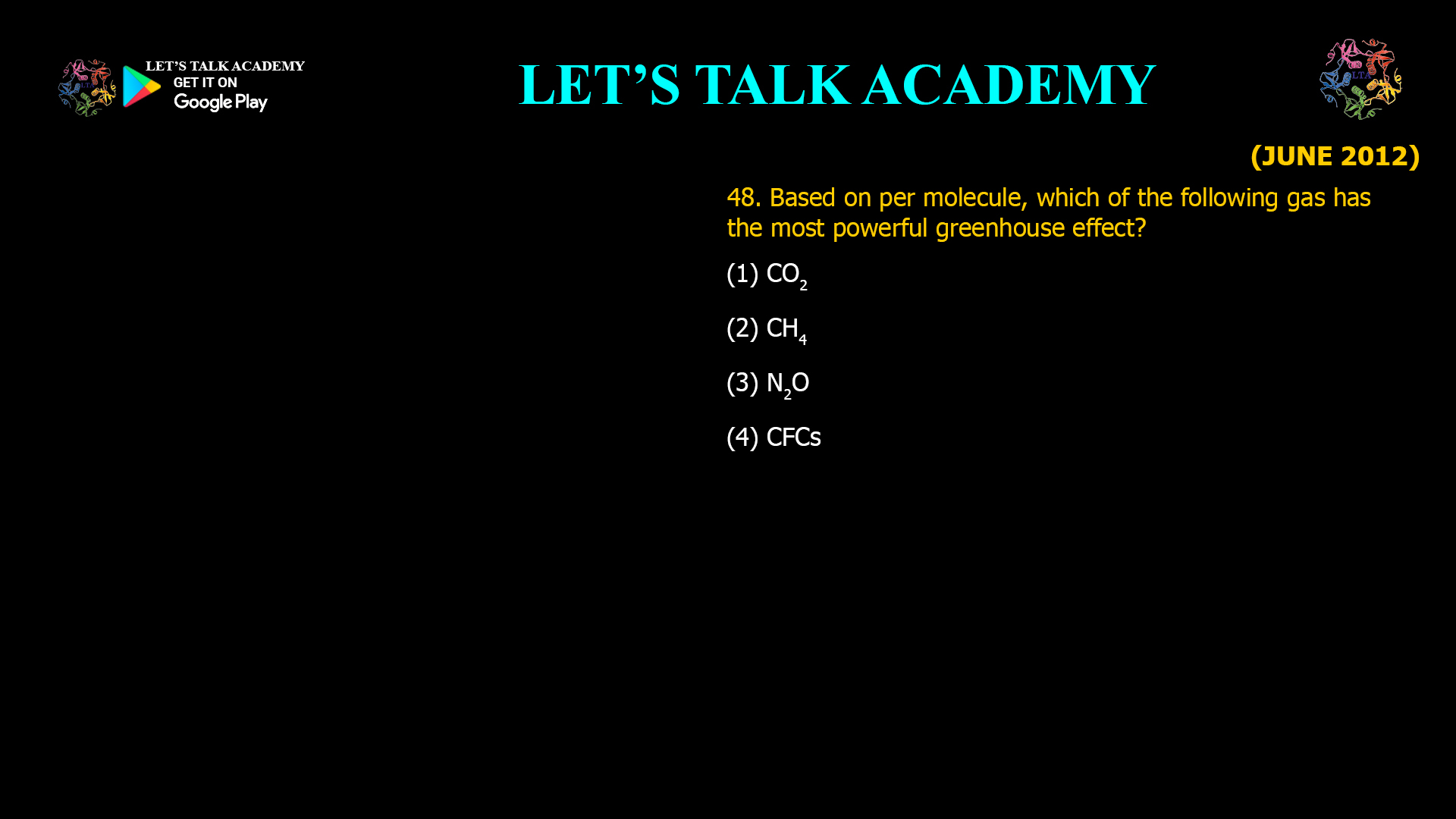- Based on per molecule, which of the following gas hasthe most powerful greenhouse effect?
(1) CO2 (2) CH4
(3) N2O (4) CFCs
What Is the Greenhouse Effect?
The greenhouse effect is a natural process where certain gases in the atmosphere absorb and re-emit infrared radiation, trapping heat and keeping Earth’s surface warmer than it would otherwise be. This effect is essential for life, but human activities have increased the concentration of greenhouse gases, intensifying the effect and leading to global warming.
Measuring Greenhouse Gas Potency
The warming effect of a greenhouse gas is measured by its global warming potential (GWP). GWP compares the amount of heat trapped by a certain mass of a gas over a specific time period (usually 100 years) to that of the same mass of CO₂. However, when comparing gases per molecule (rather than per unit mass), the potency can be even more striking.
-
CO₂: Acts as the baseline (GWP = 1).
-
CH₄: Has a GWP about 28–36 times that of CO₂ over 100 years.
-
N₂O: Has a GWP about 265–298 times that of CO₂ over 100 years.
-
CFCs: Some CFCs have GWPs in the thousands to tens of thousands (e.g., CFC-11: GWP ≈ 4,750; CFC-12: GWP ≈ 10,200).
However, some fluorinated gases (not technically CFCs but sometimes grouped with them in public discussions), such as sulfur hexafluoride (SF₆), have even higher GWPs (up to 23,900 times that of CO₂), but SF₆ is not a CFC.
Per-Molecule Greenhouse Effect
When comparing gases per molecule (not per unit mass), the potency is determined by how effectively each molecule absorbs infrared radiation and how long it stays in the atmosphere.
-
CO₂: Each CO₂ molecule is relatively weak at trapping heat, but there are so many CO₂ molecules in the atmosphere that their cumulative effect is enormous.
-
CH₄: Each methane molecule is much more effective at trapping heat than CO₂, but methane stays in the atmosphere for a shorter time (about 12 years).
-
N₂O: Each nitrous oxide molecule is even more effective than methane and stays in the atmosphere much longer (about 114 years).
-
CFCs: Each CFC molecule is extremely effective at trapping heat and can remain in the atmosphere for decades to centuries. Their per-molecule warming effect is among the highest of any greenhouse gas.
Comparing the Options
Let’s review each option in the context of per-molecule greenhouse effect:
-
(1) CO₂:
-
Per-molecule warming effect: Low compared to the other options.
-
Conclusion: Not the most powerful per molecule.
-
-
(2) CH₄:
-
Per-molecule warming effect: Much higher than CO₂, but less than N₂O and CFCs.
-
Conclusion: Not the most powerful per molecule.
-
-
(3) N₂O:
-
Per-molecule warming effect: Higher than CH₄ and CO₂, but generally less than CFCs.
-
Conclusion: Not the most powerful per molecule.
-
-
(4) CFCs:
-
Per-molecule warming effect: Among the highest of any greenhouse gas. Some CFCs have GWPs in the thousands to tens of thousands, meaning each molecule traps thousands of times more heat than a CO₂ molecule over 100 years.
-
Conclusion: Most powerful per molecule among the options given.
-
Note:
If the question included fluorinated gases like sulfur hexafluoride (SF₆), it would be even more potent than CFCs. However, among the options provided (CO₂, CH₄, N₂O, CFCs), CFCs are the most powerful per molecule.
Why Per-Molecule Potency Matters
Understanding per-molecule potency is important because:
-
It highlights the disproportionate impact of trace gases. Even small emissions of highly potent gases can have a large effect on climate.
-
It informs policy and regulation. Targeting gases with high per-molecule potency can be a cost-effective way to reduce global warming.
-
It underscores the importance of monitoring and reducing all greenhouse gases, not just CO₂.
The Role of CFCs in Climate Change
CFCs were widely used as refrigerants, solvents, and propellants until their production was phased out under the Montreal Protocol due to their role in ozone depletion. Although their use has declined, CFCs remain in the atmosphere for decades to centuries, continuing to contribute to global warming.
Key Takeaways
-
CO₂ is the most abundant greenhouse gas but is not the most powerful per molecule.
-
CH₄ and N₂O are much more potent per molecule than CO₂, but CFCs are even more powerful.
-
Among the options given (CO₂, CH₄, N₂O, CFCs), CFCs have the most powerful greenhouse effect per molecule.
-
Understanding per-molecule potency is essential for effective climate policy and emissions reduction strategies.
Summary Table
| Gas | Per-Molecule Potency (Relative to CO₂) | Notes |
|---|---|---|
| CO₂ | 1 | Baseline, low per-molecule potency |
| CH₄ | ~28–36 | Much higher than CO₂, but less than others |
| N₂O | ~265–298 | Higher than CH₄, but less than CFCs |
| CFCs | Thousands to tens of thousands | Most powerful per molecule (among options) |
Conclusion
Among the options provided—CO₂, CH₄, N₂O, and CFCs—CFCs have the most powerful greenhouse effect per molecule. Their extraordinary ability to trap heat means that even small amounts can have a significant impact on global warming. While CO₂ remains the most important greenhouse gas due to its abundance, targeting highly potent gases like CFCs is crucial for mitigating climate change.




3 Comments
Kirti Agarwal
November 6, 2025CFC
Kajal
November 15, 2025CFC
Sakshi Kanwar
November 28, 2025CFCs have the most powerful greenhouse effect